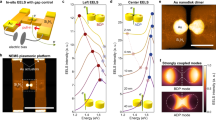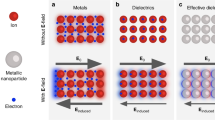Abstract
The ability to control optical effects at the nanoscale is a challenge that could be of great importance for a range of photonic applications. However, progress requires a deep understanding of the relationship between near-field and far-field properties of the individual elements of the nanostructure, as well as of the role of nano-optical interactions. Here, we show that the strong interaction between nanoholes in optically thin metal films can be used to readily tune their spectral response and visibility. Control of this interaction in short chains of nanoholes enables either amplification or almost total suppression of the scattered light. The phenomena are interpreted in terms of hole coupling mediated via antisymmetric surface plasmon polaritons, which makes the nanohole chains effectively behave as linear wire antennas.
This is a preview of subscription content, access via your institution
Access options
Subscribe to this journal
Receive 12 print issues and online access
$209.00 per year
only $17.42 per issue
Buy this article
- Purchase on Springer Link
- Instant access to full article PDF
Prices may be subject to local taxes which are calculated during checkout





Similar content being viewed by others
References
Barnes, W. L., Dereux, A. & Ebbesen, T. W. Surface plasmon subwavelength optics. Nature 424, 824–830 (2003).
Ozbay, E. Plasmonics: Merging photonics and electronics at nanoscale dimensions. Science 311, 189–193 (2006).
Ebbesen, T. W., Lezec, H. J., Ghaemi, H. F., Thio, T. & Wolff, P. A. Extraordinary optical transmission through sub-wavelength hole arrays. Nature 391, 667–669 (1998).
Maier, S. A. et al. Local detection of electromagnetic energy transport below the diffraction limit in metal nanoparticle plasmon waveguides. Nature Mater. 2, 229–232 (2003).
Andrew, P. & Barnes, W. L. Energy transfer across a metal film mediated by surface plasmon polaritons. Science 306, 1002–1005 (2004).
Bozhevolnyi, S. I., Volkov, V. S., Devaux, E. & Ebbesen, T. W. Channel plasmon-polariton guiding by subwavelength metal grooves. Phys. Rev. Lett. 95, 046802 (2005).
Fromm, D. P., Sundaramurthy, A., Schuck, P. J., Kino, G. & Moerner, W. E. Gap-dependent optical coupling of single “Bowtie” nanoantennas resonant in the visible. Nano Lett. 4, 957–961 (2004).
Muhlschlegel, P., Eisler, H. J., Martin, O. J. F., Hecht, B. & Pohl, D. W. Resonant optical antennas. Science 308, 1607–1609 (2005).
Xu, H. X., Bjerneld, E. J., Kall, M. & Borjesson, L. Spectroscopy of single hemoglobin molecules by surface enhanced Raman scattering. Phys. Rev. Lett. 83, 4357–4360 (1999).
Mirkin, C. A., Letsinger, R. L., Mucic, R. C. & Storhoff, J. J. A DNA-based method for rationally assembling nanoparticles into macroscopic materials. Nature 382, 607–609 (1996).
Haes, A. J., Chang, L., Klein, W. L. & Van Duyne, R. P. Detection of a biomarker for Alzheimer’s disease from synthetic and clinical samples using a nanoscale optical biosensor. J. Am. Chem. Soc. 127, 2264–2271 (2005).
Rindzevicius, T. et al. Plasmonic sensing characteristics of single nanometric holes. Nano Lett. 5, 2335–2339 (2005).
Pendry, J. B. Negative refraction makes a perfect lens. Phys. Rev. Lett. 85, 3966–3969 (2000).
Shelby, R. A., Smith, D. R. & Schultz, S. Experimental verification of a negative index of refraction. Science 292, 77–79 (2001).
Dolling, G., Enkrich, C., Wegener, M., Soukoulis, C. M. & Linden, S. Simultaneous negative phase and group velocity of light in a metamaterial. Science 312, 892–894 (2006).
Zhang, S. et al. Experimental demonstration of near-infrared negative-index metamaterials. Phys. Rev. Lett. 95, 137404 (2005).
Lezec, H. J. et al. Beaming light from a subwavelength aperture. Science 297, 820–822 (2002).
Degiron, A. & Ebbesen, T. W. The role of localized surface plasmon modes in the enhanced transmission of periodic subwavelength apertures. J. Opt. Pure Appl. Opt. 7, S90–S96 (2005).
Grupp, D. E., Lezec, H. J., Thio, T. & Ebbesen, T. W. Beyond the Bethe limit: Tunable enhanced light transmission through a single sub-wavelength aperture. Adv. Mater. 11, 860–862 (1999).
Ruan, Z. C. & Qiu, M. Enhanced transmission through periodic arrays of subwavelength holes: The role of localized waveguide resonances. Phys. Rev. Lett. 96, 233901 (2006).
van der Molen, K. L. et al. Role of shape and localized resonances in extraordinary transmission through periodic arrays of subwavelength holes: Experiment and theory. Phys. Rev. B 72, 045421 (2005).
Treacy, M. M. J. Dynamical diffraction explanation of the anomalous transmission of light through metallic gratings. Phys. Rev. B 66, 195105 (2002).
Vigoureux, J. M. Analysis of the Ebbesen experiment in the light of evanescent short range diffraction. Opt. Commun. 198, 257–263 (2001).
Lezec, H. J. & Thio, T. Diffracted evanescent wave model for enhanced and suppressed optical transmission through subwavelength hole arrays. Opt. Express 12, 3629–3651 (2004).
Gay, G. et al. The optical response of nanostructured surfaces and the composite diffracted evanescent wave model. Nature Phys. 2, 262–267 (2006).
Burke, J. J., Stegeman, G. I. & Tamir, T. Surface-polariton-like waves guided by thin, lossy metal-films. Phys. Rev. B 33, 5186–5201 (1986).
Rindzevicius, T. et al. Nanohole plasmons in optically thin gold films. J. Phys. Chem. C 111, 1207 (2007).
Prikulis, J., Hanarp, P., Olofsson, L., Sutherland, D. & Kall, M. Optical spectroscopy of nanometric holes in thin gold films. Nano Lett. 4, 1003–1007 (2004).
Hanarp, P., Kall, M. & Sutherland, D. S. Optical properties of short range ordered arrays of nanometer gold disks prepared by colloidal lithography. J. Phys. Chem. B 107, 5768–5772 (2003).
Draine, B. T. & Flatau, P. J. Discrete-dipole approximation for scattering calculations. J. Opt. Soc. Am. A 11, 1491–1499 (1994).
Gunnarsson, L. et al. Confined plasmons in nanofabricated single silver particle pairs: Experimental observations of strong interparticle interactions. J. Phys. Chem. B 109, 1079–1087 (2005).
Gao, H. W., Henzie, J. & Odom, T. W. Direct evidence for surface plasmon-mediated enhanced light transmission through metallic nanohole arrays. Nano Lett. 6, 2104–2108 (2006).
Chang, S. H., Gray, S. K. & Schatz, G. C. Surface plasmon generation and light transmission by isolated nanoholes and arrays of nanoholes in thin metal films. Opt. Express 13, 3150–3165 (2005).
Sepulveda, B., Lechuga, L. A. & Armelles, G. Magnetooptic effects in surface-plasmon-polaritons slab waveguides. J. Lightwave Technol. 24, 945–955 (2006).
Balanis, C. A. Antenna Theory: Analysis and Design (Wiley, New Jersey, 2005).
Acknowledgements
The authors thank P. Johansson, J. G. de Abajo, J. Aizpurua, P. Nordlander, T. Rindzevicius, T. Pakizeh and S. A. Astakhov for stimulating discussions and suggestions. Financial support from the Swedish Research Council and the Swedish Foundation for Strategic Research is gratefully acknowledged.
Author information
Authors and Affiliations
Contributions
Y.A. and L.E. prepared the samples. Y.A. and B.S. carried out optical measurements and data analysis. B.S. and M.K. made numerical simulations and analytical theory. Y.A., B.S., E.O. and M.K. planned the work. Y.A., B.S. and M.K. wrote the paper. All authors discussed the results.
Corresponding authors
Supplementary information
Supplementary Information
Supplementary Figures S1 and S2 (PDF 228 kb)
Rights and permissions
About this article
Cite this article
Alaverdyan, Y., Sepúlveda, B., Eurenius, L. et al. Optical antennas based on coupled nanoholes in thin metal films. Nature Phys 3, 884–889 (2007). https://doi.org/10.1038/nphys785
Received:
Accepted:
Published:
Issue Date:
DOI: https://doi.org/10.1038/nphys785
This article is cited by
-
Second harmonic generation hotspot on a centrosymmetric smooth silver surface
Light: Science & Applications (2018)
-
A phased antenna array for surface plasmons
Scientific Reports (2016)
-
Coupling of plasmonic nanopore pairs: facing dipoles attract each other
Light: Science & Applications (2016)
-
The Study of Tunable Local Surface Plasmon Resonances on Au-Ag and Ag-Au Core-Shell Alloy Nanostructure Particles With DDA Method
Plasmonics (2015)
-
Plasmonic nanopatch array for optical integrated circuit applications
Scientific Reports (2013)



